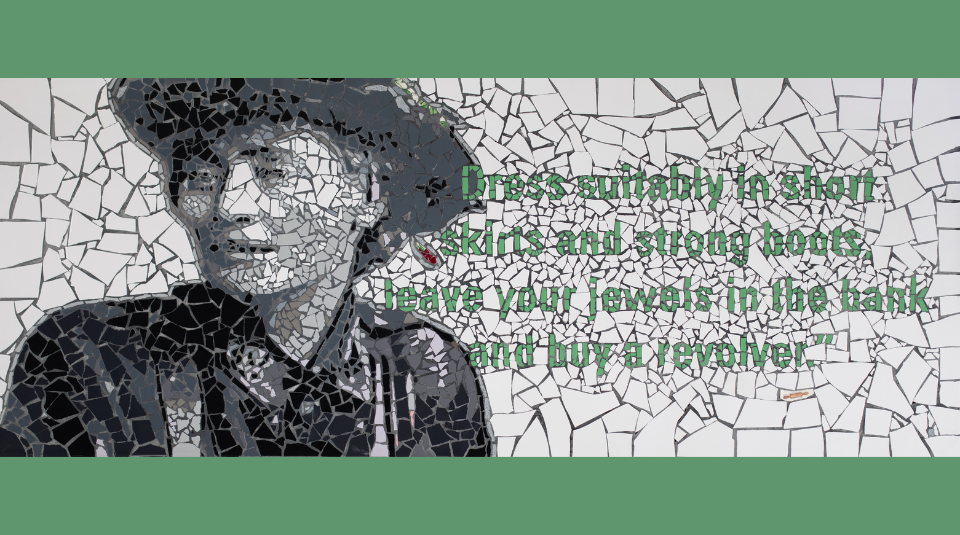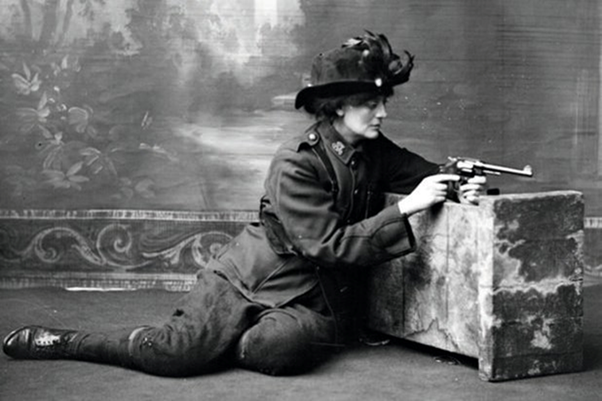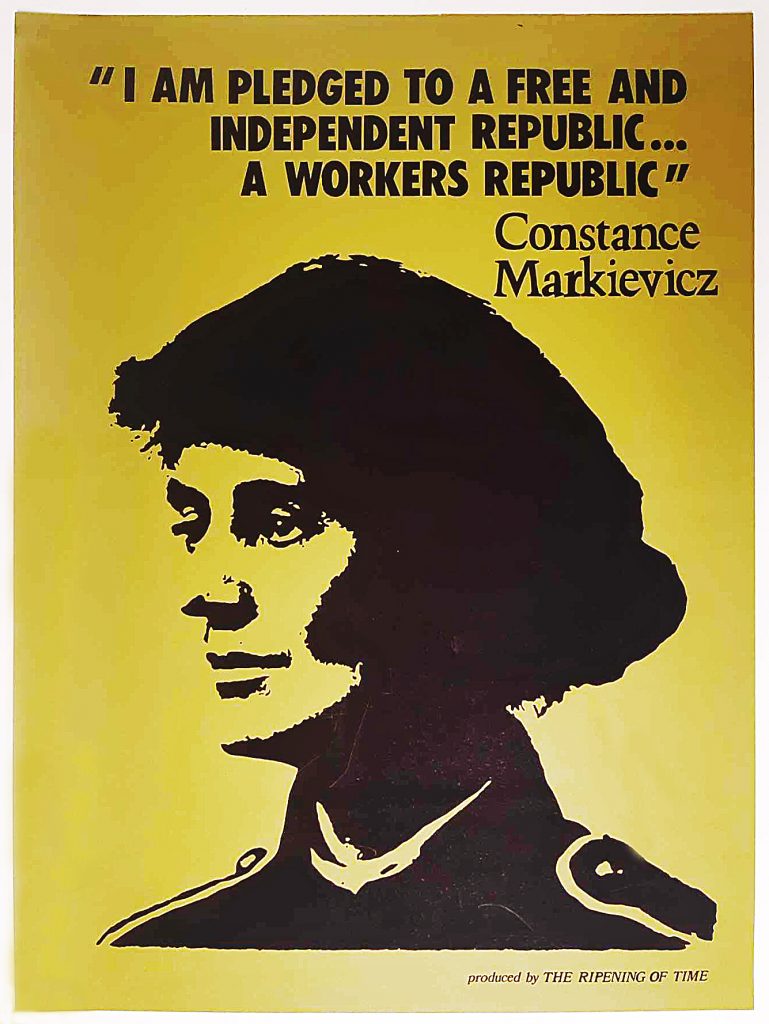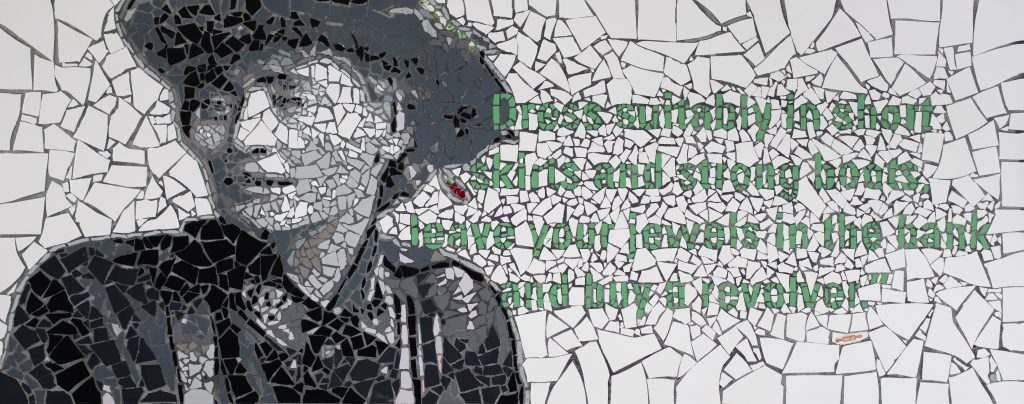
From 1 March to 29 July 2024 People’s History Museum (PHM) will be the location for world renowned mosaic artist Mark Kennedy’s mosaic of Irish revolutionary Constance Markievicz (1868-1927). PHM’s Visitor Experience Team’s Mollie Holden takes a closer look at Constance Markievicz, her fight to improve the lives of the working class, and a poster in the museum’s collection.
The mosaic of Constance Markievicz forms part of The Irish Nation Art Trail (1-31 March 2024) which features 17 unique and previously unseen pieces, representing Irish icons of literature, music, sport, and history.

Countess Constance Markievicz was a trailblazing Irish revolutionary, politician, and social activist who defied conventions and fought tirelessly for Irish independence, women’s rights, and social justice. She was a key figure in the 1916 Easter Rising, the first woman elected to the British House of Commons, and the first female cabinet minister in Ireland.
Markievicz was a leading member of the Irish Citizen Army, a socialist militia that fought alongside the Irish Volunteers in the uprising against British rule in Dublin. She commanded a garrison at St Stephen’s Green and was sentenced to death for her role in the rebellion, though the sentence was later commuted to life imprisonment.
Markievicz was a champion of the poor and working class. She established soup kitchens during the 1913 Dublin Lockout, a major labour strike, and campaigned for improved housing and healthcare for the underprivileged.
Markievicz challenged traditional gender roles throughout her life. She advocated for women’s suffrage, equal pay, and better working conditions for women. Her election to parliament and appointment as Minister for Labour served as groundbreaking achievements for women in Irish politics.
Markievicz was a passionate advocate for the working class and a staunch socialist. Here are some ways she championed workers’ rights:
Whilst it’s true that Markievicz was elected as a Member of Parliament (MP) for Dublin St Patrick’s in the 1918 UK general election, she and her fellow Sinn Féin MPs refused to take their seats in the British House of Commons as a form of protest against British rule in Ireland. This refusal to take her seat meant that she was never officially recognised as an MP, thus most people recognise Nancy Astor as the first female MP.
As the quote within the mosaic suggest, Markievicz’s use of violence in the fight for Irish independence has sparked debate. However, it’s essential to understand her actions within the context of the time and the oppressive conditions she sought to change.
Markievicz’s actions paved the way for greater female participation in Irish politics and challenged societal norms. She’s remembered as a courageous and uncompromising figure who dedicated her life to fighting for a better future for Ireland and its people.

The poster pictured above of Constance Markievicz is in the collection at People’s History Museum (PHM) and was created by The Poster Collective, a group from the Slade School of Art in London, who also created posters for the Miners’ Strike (1984-1985) and the Vietnam war (1954-1975). PHM’s collection of around 4,000 posters spans the political history of modern Britain. The posters cover dramatic world histories that have intertwined with Britain from the Russian Revolution, to the Spanish Civil War, to the dictatorial regimes in Latin America. Many of the posters have a national focus covering successive general elections. There are also posters that cover more grassroots campaigns opposing varied laws, wars, and experiences of poverty, as well as posters focusing on mobilisations and social movements in support of democracy and change.

People’s History Museum is an incredibly fitting location for Mark Kennedy’s mosaic of Constance Markievicz on The Irish National Art Trail. The museum embodies the very ideals Markievicz fought for throughout her life – social justice, workers’ rights, and challenging the status quo. Her commitment to improving the lives of the working class and underrepresented aligns perfectly with the museum’s focus on showcasing the struggles and triumphs of ordinary people in shaping history. Moreover, Manchester has a rich history of Irish diaspora and working class activism, offering an important connection to Markievicz’s revolutionary spirit and legacy.
Visit the galleries at People’s History Museum, where you can view Mark Kennedy’s mosaic of Constance Markievicz on display in Manchester councillor and suffragette Hannah Mitchell’s kitchen, which is situated in the Voters section of Gallery One.
Download your Irish Nation Art Trail map.
Explore PHM’s extensive archive collections and find out more about the fight for better employment rights and welfare reform. Delving into the museum’s Labour Party and Communist Party of Great Britain collections, as well as many others, will allow you to get a better understanding of the history of this important and continued battle. Email archive@phm.org.uk to book an appointment.
Read about Jayaben Desai who led a two year strike at the Grunwick film processing factory in north west London. Her fight for equality, improved working conditions and an end to institutionalised racism gained her national acclaim from workers across the UK. Jayaben risked her livelihood to ensure workers everywhere were treated fairly.
Subscribe to PHM’s e-newsletter to keep up to date with our latest blogs, upcoming events and exhibitions by taking our radicals quiz.
People’s History Museum is open from 10.00am to 5.00pm, every day except Tuesday. The archive is open Wednesday to Friday, 10.00am to 4.00pm (lunchtime closure 12.30pm to 1.30pm). Booking essential.